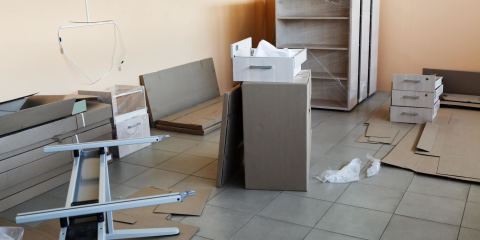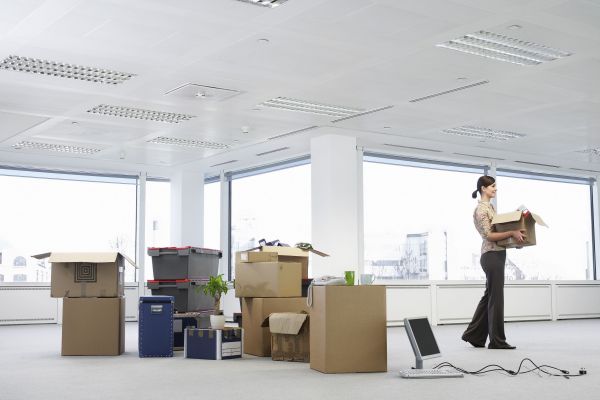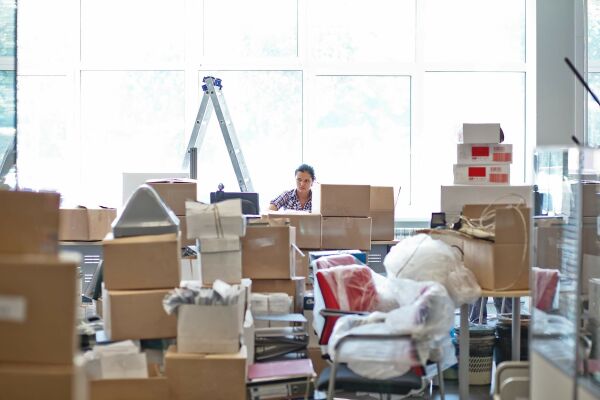Bulky, heavy, awkwardly shaped, and expensive—there’s no doubt about it, office furniture is cumbersome to move. The key to ensuring it arrives in good condition? Preparation.
There are lots of elements to consider when you’re planning an office move, from finding a new office space to transitioning your employees. With a multitude of decisions to be made and even more moving parts to coordinate, it’s easy to forget about workaday tasks like packing your office furniture.
Good news—preparing your office furniture so that it survives a move without incurring any knicks and scratches is easier than you might think—it just requires a little planning, the right materials, and some instruction.
1. Create a timeline & packing plan
If you haven’t already gone through your furniture to make an inventory and decide what to get rid of and what to keep, do so now. While you’re at it, create a packing plan and timeline so you can stay on track in the weeks to come.
Making a plan and a timeline for how you’ll tackle packing your office furniture is a good opportunity to determine what packing needs to be done and when, as well as properly sort through, measure, clean, and otherwise prepare your furniture and any other assorted items that need to be moved so they incur the least amount of damage possible.
2. Seek assistance
Whether you’re soliciting the help of your employees or paying for professional assistance, you will almost certainly need help with at least one or two stages of the office moving process.
Because it is so bulky and heavy, office furniture can rarely be moved as-is. Between this and the fact that any disassembly requires at least 2-3 people to hold things steady while taking them apart, you may be better off asking your professionals for help. We don’t recommend asking your employees—they aren’t professionals and could get injured at your expense—but if you do enlist the assistance of your employees, be sure to provide boxes and instructions for how to clear out and pack up their office- or cubicle-contents and office furniture.
PRO TIP: If you are planning to hire a moving company to aid in the office or commercial relocation process, reach out to them early and with a clear picture of the items you plan to have moved. Knowing the amount of furniture to be moved, as well as the dimensions and weights of those items will ensure you get the most accurate quote possible.
3. Gather materials, supplies & equipment
With a plan in place and helpers lined up, it is time to pick up any materials, supplies, or equipment needed to pack up your office furniture.
We recommend that you buy new materials or reuse very gently-used supplies, such as the original boxes any electronics came in if you happened to keep them on hand. Don’t use anything that shows signs of wear; for example, if most of the bubbles are popped, if the box has rips, tears, dents, or looks visibly worn, or if the packing paper has already been crumpled and ripped. Think of these supplies as an investment in the safety of your furniture—they will offer better protection, and will save you from the heartache of scratches, chips, and other damages.
To properly and securely disassemble and pack your office furniture, you will need:
- Tools
- Screwdrivers
- Pliers
- Hammer
- Scissors
- Box cutter
- Bubble wrap
- Packing tape
- Corrugated cardboard sheets
- Cardboard boxes for disassembled and smaller items
- Ink-free packing paper (do not use newspaper)
- Plastic stretch wrap
- Moving blankets
- Sealable plastic bags
- Foam sheets
- Zip ties
- Corner protectors
- Sofa covers
- Permanent markers
For a DIY move where you will be loading and unloading the furniture yourself or with the help of volunteers (we do not recommend asking your employees to physically move office furniture), you will also need some items that are typically supplied by the moving company, including:
- Furniture pads
- Moving straps or ropes
- Personal protective equipment (PPE)
- Corner guards
- Foam padding sheets or moving blankets
- Plywood sheets
- A dolly
4. Prepare the pieces for packing
To get office furniture and electronic equipment ready to move, have your employees clean, back-up, and empty any of the storage furniture and electronic equipment they have in their offices. They know best what these items contain.
Set deadlines and instruct them to:
- Pack up and take home any personal belongings.
- Sort and declutter anything that they no longer want or need.
- Sort and safely declutter anything that is no longer necessary for the business—make sure sensitive documents are properly disposed of via shredding or deconstruction bins.
- Pack up the remaining documents and files in plastic file totes or heavy duty storage boxes, setting aside any files that contain sensitive or identifying information. For security reasons, you should plan to personally transport this information to the new location.
- Clearly indicate which office the files should be placed into at your new location, as well as where they belong in said office for easy unpacking.
- Pack up the remaining supplies, books, equipment, and any odds and ends in cardboard boxes and clearly label them.
PRO TIP: If you do not have cleaners who will wipe down your office furniture for you and you are not confident asking your employees, consider hiring a cleaning team specially for the move and arrange for them to come after your employees have finished emptying out the furniture. Whatever option you choose, cleaning your furniture is an important step that you should not skip—dust, dirt, and debris can cause scratches and other surface damage when you pack up the furniture and move it.
How to prepare electronics
For electronic equipment, have your IT team back up any essential documents to the cloud or an external hard drive. If your company is too small to have a dedicated IT team, ask your employees to do this step themselves, or hire someone to come in.
5. Take apart anything that can be disassembled
The smaller the pieces, the easier they are to pack and carry. Disassemble any furniture that can be taken apart and that it makes sense to disassemble, including:
- Cushions
- Knobs and handles
- Casters
- Legs
- Drawers
- Shelves
- Cables and other components
- Mounting or stand components
If you still have them handy, consult the assembly instructions that came with the pieces. Otherwise, take photos at every stage to make sure you know how to put them back together.
PRO TIP: While disassembling the furniture, immediately place any screws, nuts, bolts, cables, or other small items in a sealable plastic bag. Label the bag and affix it to a large piece of the furniture/item or the box it is going to go into. Before you attach the bag to the furniture, double-check that it’s a surface that won’t be damaged by tape.
If you can’t remove drawers or shelves, you can secure them in place using tape and stretch wrap. Just check with your moving company first—they may have rules about how they’ll move furniture.
6. Wrapping & packing
With your office furniture cleaned out and disassembled, it is time to create a packing station to finish the process. Start by clearing out a large, flat space in the room you will be packing in and laying out your supplies.
Electronic equipment
With electronics, you want to ensure that no screens get cracked and that their delicate internal components don’t get banged around too much during the move. If you have not already done so, remove and bundle the cables and place them in the box with the device, then follow these steps:
- Start by wrapping the device in a layer of packing paper and securing it with tape.
- For screens, place a sheet of packing paper overtop of the screen before adding a layer of bubble wrap. Packing paper will protect the screen from any marks that might be left by bubble wrap.
- For a laptop, place a thin layer of foam sheeting between the screen and the keyboard and close the laptop.
- Wrap a generous layer of bubble wrap around the device, overtop of the packing paper. Secure it in place with tape.
- Cover the front of the screen and any other fragile components with a thick piece of cardboard cut to size.
- Attach corner protectors to each of the corners, or craft your own by cutting up pieces of cardboard and taping them together.
- Choose a box that is slightly larger than the size of the device. Add a layer of your cushioning material of choice in the bottom of the box.
- Place the item in a box and fill any remaining space with more cushioning material before sealing and labelling the box with its contents.
- Clearly label the box as “FRAGILE”.
PRO TIP: If you have them on hand and they are in good condition, the original boxes and padding materials will provide the best cushioning to keep these devices safe during transport. If you have good quality laptop bags, these will also work well as cushioning for laptops. Simply load the laptop into the bag and place it inside of an appropriately-sized box.
Furniture
When it comes to furniture, you want to pack it so that it is protected from scratches, bangs, and cracks. With the pieces already disassembled as much as possible, you are ready to wrap up your office furniture.
- For furniture with glass pieces that cannot be removed, place packing paper over the glass, followed by a sheet of cardboard cut to size. Then wrap with bubble wrap over the glass portion, followed by a sheet of cardboard cut to size. Do the same with any decorative or delicate components.
- Where possible, add corner protectors to all of the corners on the piece and secure them in place with painter’s tape or stretch wrap.
- Wrap corrugated cardboard around the legs and secure them in place with packing tape. Follow this with a layer of bubble wrap. Avoid placing tape directly on any finished surfaces—the tape could cause damage during removal. If you need to adhere tape directly to the surface of any furniture, use painter’s tape.
- Wrap large pieces and legs in thick moving blankets and secure the blankets in place with stretch wrap.
- For sofas, cover them with plastic sofa covers to protect them from rips and stains.
- For leather furniture, avoid using plastic packing materials entirely—they can cause damage to the leather, especially in higher temperatures. To keep them as safe as possible, stick with moving blankets and take care not to let any tape touch the leather surface.
Conclusion
Preparing your furniture for an office relocation is as easy as:
- Planning ahead
- Asking for help when you need it
- Picking up the right supplies for packing
- Cleaning and emptying the furniture and backing up any important data
- Disassembling the furniture as much as possible
- Carefully wrapping and packing it
With your office furniture prepped and packed, you’re ready for relocation!
Full-service business shipping solutions
Including truckload, LTL, expedited and time critical, international shipments, air-ride suspension, and more.




